Snow Goose

Thrilled by the show, I continued snowshoeing south, following the path that meanders near the edge of the South Tivoli Bay. The Bay is wide and shallow, often freezing up before the rest of the river. Snow covered the ground and the temperatures hovered near freezing. I could see that the Bay had a thin coat of ice, gleaming in the high noon sun. There are three underpasses that lead to the Hudson River and near those underpasses stood open water. There had to be ducks nearby.

Thrilled by the show, I continued snowshoeing south, following the path that meanders near the edge of the South Tivoli Bay. The Bay is wide and shallow, often freezing up before the rest of the river. Snow covered the ground and the temperatures hovered near freezing. I could see that the Bay had a thin coat of ice, gleaming in the high noon sun. There are three underpasses that lead to the Hudson River and near those underpasses stood open water. There had to be ducks nearby.
 Goose bedraggled; photo by Bard student Christina BaalI arrived at a jut of land affectionately referred to as Buttocks Island. I walked out through the crevice of the island and peered south. A flock of Ring-Billed Gulls stood on the thin sheet of ice. Soon, the heron joined them, standing tall next to its shorter compatriots. I spotted the eagle in a far tree on the end of Cruger Island, perched near a mature eagle, it’s white head visible without my binoculars. The immature eagle flew over, swooping low over the gulls. They all took to the air, while the heron stood, refusing to engage in another chase.
Goose bedraggled; photo by Bard student Christina BaalI arrived at a jut of land affectionately referred to as Buttocks Island. I walked out through the crevice of the island and peered south. A flock of Ring-Billed Gulls stood on the thin sheet of ice. Soon, the heron joined them, standing tall next to its shorter compatriots. I spotted the eagle in a far tree on the end of Cruger Island, perched near a mature eagle, it’s white head visible without my binoculars. The immature eagle flew over, swooping low over the gulls. They all took to the air, while the heron stood, refusing to engage in another chase.
I loitered for a while, scoping the Common Mergansers floating in the open water near the underpass. Beyond the underpass I could see the far shore of the river, the hamlet of Glasco and the Catskills, lumpy blue, in the background. It was a perfect blue-sky day, the sort of day that demands time outside.
I poked around the south side of Buttock’s Island, hoping without much hope, to see a Snow Goose there. Just after Hurricane Sandy swept through, the Goose arrived. It looked pretty bedraggled, white feathers all askew. When thousands of Snow Geese migrated through the valley this fall it did not pick up and join its cousins. I assumed it was too injured to fly. Despite this, the bird had made it through December, with frequent visits from Bard College students, eager to see a special bird. Through the fall I had grown fond of the bird, thought of it as my goose, and had resisted an urge to feed it.
The bird wasn’t there, of course. I refused to get sentimental. This was just nature taking her course. A fox or a coyote could have made it a good meal.
I continued on my way, taking the narrow path that rolls over hillocks and hugs the South Tivoli Bay. The views through the trees were long, out to patches of open water where Black Ducks floated. As I approached the mouth of the Sawkill, I heard the cackle of the Kingfisher that had been there all summer and fall. And then, to my amazement, there was my goose, idling in the open water! It shoved further out as I approached, full of admiration for its will to live.
River Time
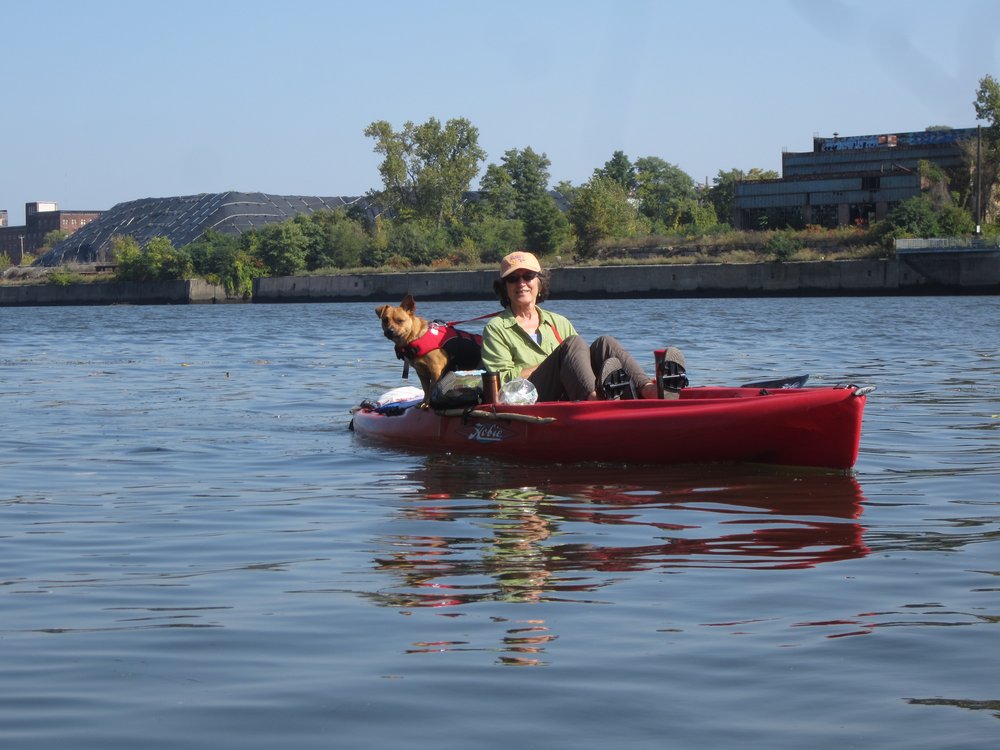
We included Merle, who at age 72 teaches Outward Bound courses, has a shock of curly gray-white hair and a calm steady demeanor; Kate on her pedal boat, after shoulder surgery, long legs shoving south; and me, on a short fall break from teaching, desperate not to think about faculty meetings. The most important team member, however, was Neena, a pint sized dog, which Kate had just rescued. This was Neena’s river baptism. To keep her happy--and who doesn't want to keep a dog happy--we stopped every hour to stretch and pee and marvel over how slowly we were moving.

We included Merle, who at age 72 teaches Outward Bound courses, has a shock of curly gray-white hair and a calm steady demeanor; Kate on her pedal boat, after shoulder surgery, long legs shoving south; and me, on a short fall break from teaching, desperate not to think about faculty meetings. The most important team member, however, was Neena, a pint sized dog, which Kate had just rescued. This was Neena’s river baptism. To keep her happy--and who doesn't want to keep a dog happy--we stopped every hour to stretch and pee and marvel over how slowly we were moving.
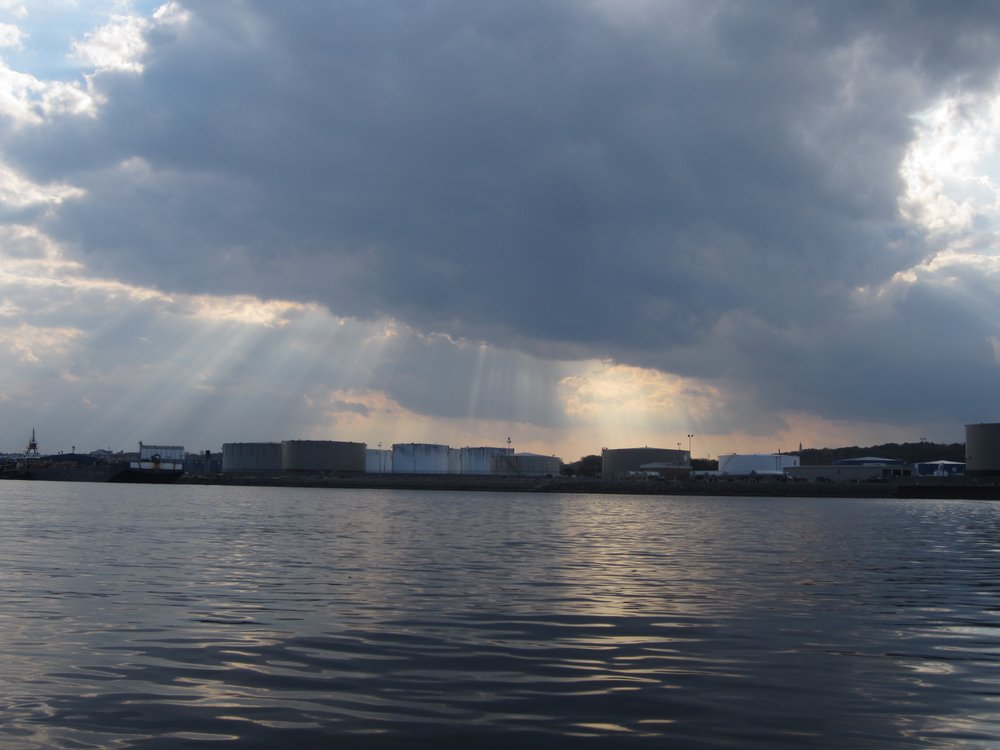
We needed a campsite in this unlovely place. Room for three tents, three boats, three tired women. Papscanee Island is not quite an island, and is rimmed with wooden pylons, visible at low tide, and beyond the pylons, rocks covered over with...asphalt. The asphalt was often cracked in a yawn to reveal a jumble of rock teeth. The Hudson River Watertrail guide states "There is no river access for boaters." But, we needed access into the trees. And that is what we found, directly across the narrow river from a set of oil tanks.
Once dark settled in, once we had eaten our magnificent burritos--all river food is delicious--we realized that the spot lights from the oil tanks were going to keep us company through the night. I had been yearning for the quiet that is sleeping with my back to the ground. But that is not what we had that night. At two in the morning a barge arrived, pushed by a roaring little tug. And they began to offload oil, using enormous diesel powered pumps. They were still pumping when we pulled our near sleepless bodies from our tents.
"That wins for the worst campsite of my life," I joked.
You would think at this point I would speak of grumpiness, of bad temper, or perhaps even the nuttiness of this adventure. Instead, I'm going to write of giddiness as we shoved south, of wonder as I counted the bald eagles that soared over us, or perched in a nearby tree, fishing for their next meal. By the end of the day I had counted twenty-two of the big birds, birds that but twenty years ago had all but vanished from the Hudson Valley. I allowed myself a drop of hope.
First the wind gusted from the south, making our passage a trial, then it shifted to the north, making it a joy. We scooted along, and by four in the afternoon, we pulled onto the sandy shore of Gays Point.
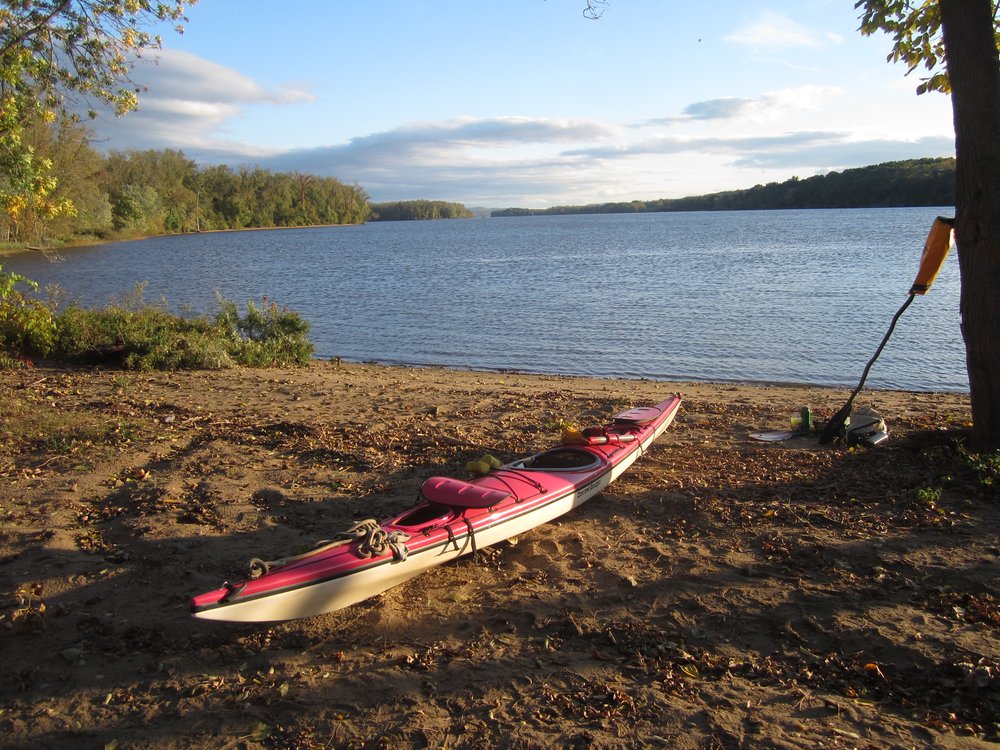
The smooth river pulled me early from my tent, to oatmeal and coffee. Before we slipped into our boats, we stood with our toes in the water and "clapped on" the river. Merle spoke of the beauty and necessity of this river, our time on it. It was but a drop of time, but at that moment I felt like we had been there for days, weeks, my body settled into its aches, my mind into the quiet thoughts that emerged from what I saw. Nothing more.
Then we pushed south, wondering where our adventure would end. As I approached Stockport Middle Grounds, the first flock of Brant coursed by over head. Six more flocks of the small dark geese flapped by, bringing news of the Arctic, and of colder weather, of winter.
I was now in familiar land, reaches I had paddled many times before: Middle Ground Flats, the quirky village of Athens, the Rip Van Winkle bridge. I knew the zig zag path of the channel in this section and how the eastern shore is shallow at low tide.
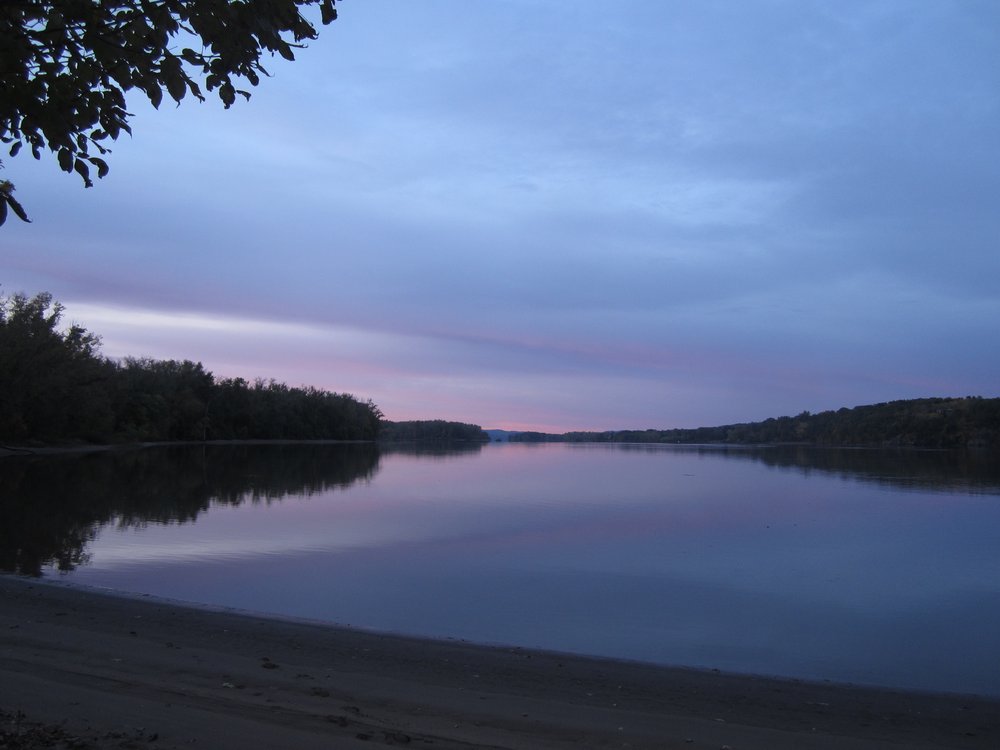
Merle, Kate and I stood with our toes in the water and "clapped off." Merle spoke with a clear wisdom, thanking the river for our time, the company, the adventures had and to come. I had tears in my eyes as we all clapped our goodbye to the river.
Squirrel Madness
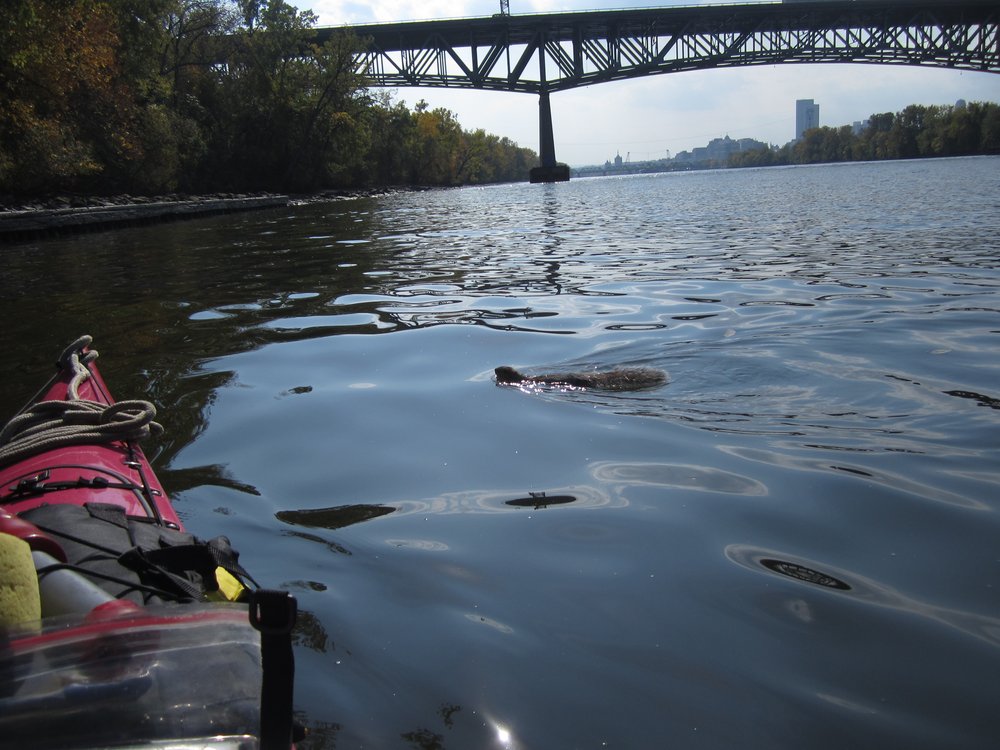
But there, near the bow of my boat, I spied something moving in the water. I usually see beaver or musk rat, sometimes I see snapping turtles, the V of their heads cutting the surface in the Tivoli Bay. This was not any of those familiar creatures. The animal had a fluffy gray tail that floated on the surface of the water, then a tiny head that was barely cutting the surface. A squirrel!

But there, near the bow of my boat, I spied something moving in the water. I usually see beaver or musk rat, sometimes I see snapping turtles, the V of their heads cutting the surface in the Tivoli Bay. This was not any of those familiar creatures. The animal had a fluffy gray tail that floated on the surface of the water, then a tiny head that was barely cutting the surface. A squirrel!

But here was a squirrel swimming the river, an athletic feat I had only seen once before. I steered toward the squirrel, then dropped my paddle and reached for my camera. As I started to point and shoot, I realized we were on a collision course. I tried to back stroke, but heard a small thunk. My heart sunk: I had just run over a squirrel, with my kayak. Then I saw the tiny paws reach up, grab one of the deck lines, and do a small pull up. Suddenly the soaked squirrel was perched on my sponge. We looked at each other. I apologized. I promised the squirrel I would take it to shore. The squirrel walked daintily to the end of my boat, and waited for safe passage. I slid onto shore and it sat there for a moment. Then it made the leap, and walked off to the woods.
Love at First Snap
After the first day of my nature writing class at Bard College, a student came up to me and said, “I have twenty baby snapping turtles at home.”
My heart leapt. There is nothing cuter than a baby snapping turtle, not even a kitten. They look like miniature dragons with oversized heads, fragile little shells and spunk. They are all purpose and who doesn’t love a creature that is fully itself, confident in its turtleness. A baby turtle is not yet the belligerent, large snapping adult they will become—when I love them even more.
My student’s lively story unfolded. A friend was building a house in Rhode Island and dug up a snapper nest. He gave her the eggs, which she proceeded to keep in a box of soil in a warm room all summer long. Her mother-in-law arrived from time to time to tell her to just throw out the eggs. But she held on, and finally last week little limbs started to emerge from the ping-pong sized eggs. It took several days for the babies to emerge; every single egg hatched. The turtles had been in the world for three days, living off of their yolk sacks. They now needed to be released.

My heart leapt. There is nothing cuter than a baby snapping turtle, not even a kitten. They look like miniature dragons with oversized heads, fragile little shells and spunk. They are all purpose and who doesn’t love a creature that is fully itself, confident in its turtleness. A baby turtle is not yet the belligerent, large snapping adult they will become—when I love them even more.
My student’s lively story unfolded. A friend was building a house in Rhode Island and dug up a snapper nest. He gave her the eggs, which she proceeded to keep in a box of soil in a warm room all summer long. Her mother-in-law arrived from time to time to tell her to just throw out the eggs. But she held on, and finally last week little limbs started to emerge from the ping-pong sized eggs. It took several days for the babies to emerge; every single egg hatched. The turtles had been in the world for three days, living off of their yolk sacks. They now needed to be released.
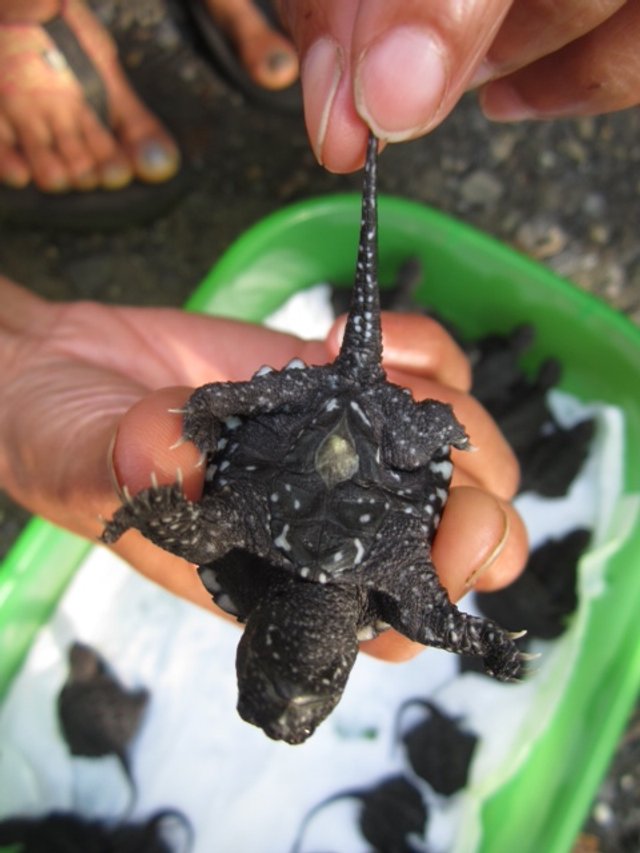
In May, snapping turtles travel from the water to that just-right spot to lay their eggs. It is in May that we find snappers crossing the roads, or, sadly, crushed as they try and do so. I’ve come across snappers scooting into the soil, digging in deeper with hind legs in order to lay a clutch. And, I’ve found the eggs, like torn white leather, littering a hillside after a raccoon has had a good egg snack. And, I’d seen baby turtles marching toward their future, as uncertain as it is. But an entire clutch of baby turtles—I had never seen this before. Ignoring the legal aspect of this (in New York State, you are not allowed to take or transport reptiles), I told her (after consulting with a local ecologist) to bring the babies to the South Tivoli Bay for release.
At five thirty on a Thursday afternoon my student and her husband (who leads eco tours in Peru) arrived in a Prius down the steep rocky road to the Bard Field Station. She held a green plastic dish that contained the dark, eager little turtles. They had long pointed tails, and spiny backs. They clambered on top of each other, stretching their oversized heads toward the sky, trying to escape their plastic prison. On the route to this release, my student had found yet another baby snapping turtle on the road. She held this grey-looking turtle in one hand. We now had an excess of turtles to love.
the more quiet local turtleThe local turtle, huddled in its little shell was a contrast to the home-raised turtles, black and all flailing limbs. They had tiny beaks, which they had used to work their way out of their shells, and some still had a yolk sack on their stomachs. We admired their energy for a while, then went in search of a perfect release spot in the Saw Kill, which drops into the South Tivoli Bay. This Bay, wide and open, is somewhat sealed off from the larger Hudson River by the railroad tracks. It’s a perfect environment in which a turtle can grow.
When I kayak in the North and South Tivoli Bays I almost always see a V in the water. If it is a deep V I think Muskrat or Beaver. If it is a shallow V I think snapper, and look for their triangular-shaped heads moving through the water. I sometimes catch up to a turtle and watch the large, almost flat shells sink into the murk. I have often wanted to hop out of my boat and pursue the turtles as I’ve heard that snappers don’t snap in water. But I’ve seen them snap on land and the speed and strength of that keeps me snug in my boat.
We walked upstream, and as we approached the rush of water, the local turtle, which I held in one hand, came alive. It pushed against the palm of my hand with its sturdy legs, wanting to enter the water. I cupped it gently, then stooped to set it free on a flat rock near the moving water. It scrambled with no fear toward the edge of the rock and plunged into the water. I watched it pedal its legs in the clear stream as it was carried off in the current.
“Maybe we should release the other turtles in quieter waters,” I said. I worried that this turtle would be swept over a small falls, would be tossed about. Of course my worries were tame ones—this turtle had a lot more to worry about than a small falls, which it could surely navigate.
We scooped up the little turtles and plunked them into the stiller waters of a cove. They swam free, and then some returned to shore, clambered out on rocks, as if to say a final goodbye. They looked alert, ready for their new lives. But we, of course, we not ready to say goodbye, especially my student who had tended to them all summer long. We lingered, watching and laughing as they clambered about in their new home. And then we knew we had to leave. As we walked off I thought how wonderful it would be to know what happened to one of these small lives. And I thought how wonderful it was that I would never know.



